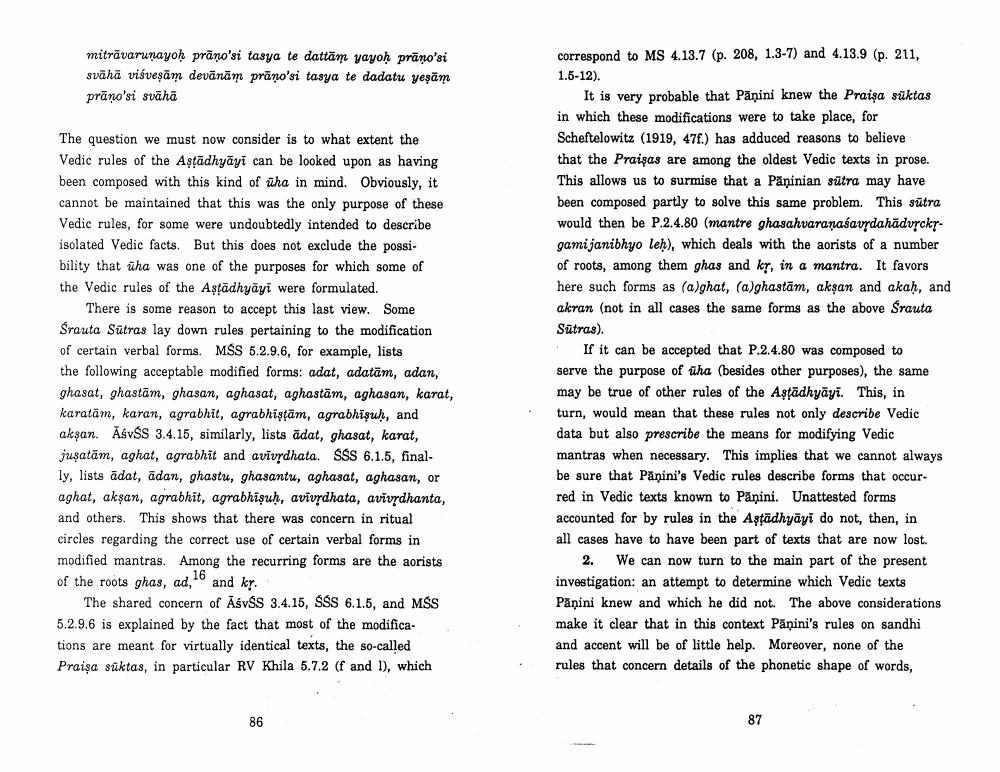Book Title: Paninian And Veda Reconsidered Author(s): Johannes Bronkhorst Publisher: Johannes Bronkhorst View full book textPage 7
________________ miträvaruṇayoḥ prano'si tasya te dattam yayoḥ prano'si svāhā visveṣām devānām prāno'si tasya te dadatu yeṣām prāno'si svāhā The question we must now consider is to what extent the Vedic rules of the Aṣṭadhyayi can be looked upon as having been composed with this kind of uha in mind. Obviously, it cannot be maintained that this was the only purpose of these Vedic rules, for some were undoubtedly intended to describe isolated Vedic facts. But this does not exclude the possibility that uha was one of the purposes for which some of the Vedic rules of the Aṣṭadhyayi were formulated. There is some reason to accept this last view. Some Srauta Sutras lay down rules pertaining to the modification of certain verbal forms. MSS 5.2.9.6, for example, lists the following acceptable modified forms: adat, adatām, adan, ghasat, ghastam, ghasan, aghasat, aghastam, aghasan, karat, karatām, karan, agrabhit, agrabhiṣṭām, agrabhişuḥ, and akṣan. AsvSS 3.4.15, similarly, lists adat, ghasat, karat, juşatām, aghat, agrabhit and avivṛdhata. SSS 6.1.5, finally, lists adat, ädan, ghastu, ghasantu, aghasat, aghasan, or aghat, akşan, agrabhit, agrabhişuḥ, avivṛdhata, avivṛdhanta, and others. This shows that there was concern in ritual circles regarding the correct use of certain verbal forms in modified mantras. Among the recurring forms are the aorists of the roots ghas, ad," and kr. 16 The shared concern of AsvSS 3.4.15, SSS 6.1.5, and MSS 5.2.9.6 is explained by the fact that most of the modifications are meant for virtually identical texts, the so-called Praisa sūktas, in particular RV Khila 5.7.2 (f and 1), which 86 correspond to MS 4.13.7 (p. 208, 1.3-7) and 4.13.9 (p. 211, 1.5-12). It is very probable that Panini knew the Praisa suktas in which these modifications were to take place, for Scheftelowitz (1919, 47f.) has adduced reasons to believe that the Praisas are among the oldest Vedic texts in prose. This allows us to surmise that a Paninian sutra may have been composed partly to solve this same problem. This sūtra would then be P.2.4.80 (mantre ghasahvaraṇaśavṛdahādvṛckygamijanibhyo leh), which deals with the aorists of a number of roots, among them ghas and kr, in a mantra. It favors here such forms as (a)ghat, (a)ghastam, akşan and akaḥ, and akran (not in all cases the same forms as the above Śrauta Sūtras). If it can be accepted that P.2.4.80 was composed to serve the purpose of uha (besides other purposes), the same may be true of other rules of the Aṣṭādhyāyā. This, in turn, would mean that these rules not only describe Vedic data but also prescribe the means for modifying Vedic mantras when necessary. This implies that we cannot always be sure that Pănini's Vedic rules describe forms that occurred in Vedic texts known to Panini. Unattested forms accounted for by rules in the Astadhyāyi do not, then, in all cases have to have been part of texts that are now lost. 2. We can now turn to the main part of the present investigation: an attempt to determine which Vedic texts Pāņini knew and which he did not. The above considerations make it clear that in this context Panini's rules on sandhi and accent will be of little help. Moreover, none of the rules that concern details of the phonetic shape of words, 87Page Navigation
1 ... 5 6 7 8 9 10 11 12 13 14 15 16 17 18 19 20 21 22 23 24
